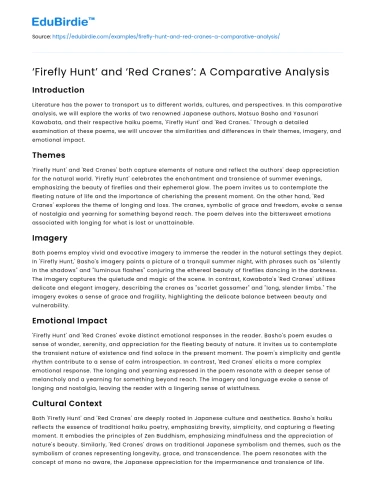Introduction
Literature has the power to transport us to different worlds, cultures, and perspectives. In this comparative analysis, we will explore the works of two renowned Japanese authors, Matsuo Basho and Yasunari Kawabata, and their respective haiku poems, 'Firefly Hunt' and 'Red Cranes.' Through a detailed examination of these poems, we will uncover the similarities and differences in their themes, imagery, and emotional impact.
Themes
'Firefly Hunt' and 'Red Cranes' both capture elements of nature and reflect the authors' deep appreciation for the natural world. 'Firefly Hunt' celebrates the enchantment and transience of summer evenings, emphasizing the beauty of fireflies and their ephemeral glow. The poem invites us to contemplate the fleeting nature of life and the importance of cherishing the present moment. On the other hand, 'Red Cranes' explores the theme of longing and loss. The cranes, symbolic of grace and freedom, evoke a sense of nostalgia and yearning for something beyond reach. The poem delves into the bittersweet emotions associated with longing for what is lost or unattainable.
Save your time!
We can take care of your essay
- Proper editing and formatting
- Free revision, title page, and bibliography
- Flexible prices and money-back guarantee
Imagery
Both poems employ vivid and evocative imagery to immerse the reader in the natural settings they depict. In 'Firefly Hunt,' Basho's imagery paints a picture of a tranquil summer night, with phrases such as "silently in the shadows" and "luminous flashes" conjuring the ethereal beauty of fireflies dancing in the darkness. The imagery captures the quietude and magic of the scene. In contrast, Kawabata's 'Red Cranes' utilizes delicate and elegant imagery, describing the cranes as "scarlet gossamer" and "long, slender limbs." The imagery evokes a sense of grace and fragility, highlighting the delicate balance between beauty and vulnerability.
Emotional Impact
'Firefly Hunt' and 'Red Cranes' evoke distinct emotional responses in the reader. Basho's poem exudes a sense of wonder, serenity, and appreciation for the fleeting beauty of nature. It invites us to contemplate the transient nature of existence and find solace in the present moment. The poem's simplicity and gentle rhythm contribute to a sense of calm introspection. In contrast, 'Red Cranes' elicits a more complex emotional response. The longing and yearning expressed in the poem resonate with a deeper sense of melancholy and a yearning for something beyond reach. The imagery and language evoke a sense of longing and nostalgia, leaving the reader with a lingering sense of wistfulness.
Cultural Context
Both 'Firefly Hunt' and 'Red Cranes' are deeply rooted in Japanese culture and aesthetics. Basho's haiku reflects the essence of traditional haiku poetry, emphasizing brevity, simplicity, and capturing a fleeting moment. It embodies the principles of Zen Buddhism, emphasizing mindfulness and the appreciation of nature's beauty. Similarly, 'Red Cranes' draws on traditional Japanese symbolism and themes, such as the symbolism of cranes representing longevity, grace, and transcendence. The poem resonates with the concept of mono no aware, the Japanese appreciation for the impermanence and transience of life.
Conclusion
In conclusion, the comparative analysis of 'Firefly Hunt' and 'Red Cranes' reveals the shared appreciation for nature and the transient beauty of life present in both haiku poems. While 'Firefly Hunt' celebrates the enchantment of a summer evening and the importance of embracing the present moment, 'Red Cranes' explores themes of longing and loss, evoking a sense of nostalgia and yearning for what is unattainable. Through their use of imagery and emotional impact, both poems invite readers to reflect on the beauty of the natural world and the complex emotions it stirs within us. By understanding the similarities and differences between these two works, we gain a deeper appreciation for the rich tapestry of Japanese literature and the enduring power of haiku poetry.






 Stuck on your essay?
Stuck on your essay?

